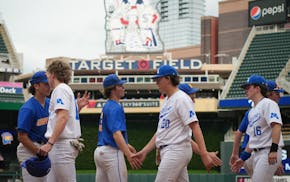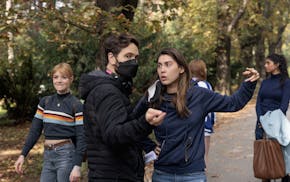What does it feel like to fly?
Some ski jumpers who get air across the metro have the answer.
Sophia Schreiner, 14, a freshman at Champlin Park High School, has been jumping for five years or more. She has experienced the thrill of a great jump.
"I got really high in the air at the end of the jump, and I felt this huge rush of adrenaline. I don't know how to like describe the feeling it was just like, 'Oh wow, I just did that.' Then you can't wait to jump again as quickly as you can."
Schreiner is a member of Minneapolis Ski Jumping Club, part of the Minneapolis Ski Club which has been jumping at Hyland Lake Park Reserve in Bloomington since the 1930s. Across town, the St. Paul Ski Club came together even further back — 1885. Hyland boasts a 70-meter jump, while St. Paul's highest ski jump platform (46 meters) at Harrington Hill in Maplewood is visible from Interstate 494.
Both clubs have similar approaches: Introduce children to the sport on progressive jumps and develop their skills until they reach adulthood. The clubs attract new members from kids who switch from alpine or cross-country skiing. Some, too, have been invited by their ski-jumping friends. Many ski jumpers come from families with several generations of experience in the sport. Currently, there are 30 jumpers who train in St. Paul; 15 in the Minneapolis club.
Nick Johnson, a coach with the Minneapolis Ski Jumping Club, and Brian Wallace, head coach of the St. Paul club, started jumping at the same age of some of their charges. Both were younger than 10. Under the guidance of club coaches, both excelled, improved and competed in international competitions. After "retiring," both returned home to become coaches. In 2018, Wallace, 25, received the USA Nordic Coach of the Year award from USA Nordic, ski jumping's governing body.
After experiencing the excitement of ski jumping, Johnson, 28, said he enjoys helping young jumpers feel that rush.
"That thrill is definitely what keeps me coming back to the sport. I want other people to experience it, too. We help them push to a point where it's kind of scary. Then all of a sudden they get this crazy amount of confidence and then feel different afterward," Johnson said. "You can just feel your body rise up like an elevator and you are hyper-aware of everything going on around you. With every little milestone you have in this sport, kids will say, 'Whoa, this is great.' "
Perceptions of ski jumping are clearly differentiated by time. For baby boomers, the most memorable image of ski jumping comes from the ABC "Wide World of Sports' " introduction of the '70s: the "Agony of Defeat" film clip of a crashing jumper. A younger generation calls the 2016 movie "Eddie the Eagle" its introduction to the sport. For 20-somethings, the reference changes significantly. Instead of the traditional approach, ESPN's Winter X Games' freestyle ski competitions is the point of reference. Johnson said first conversations about his ski jumping experience usually include the question, "How many flips and spins can you do?" A bit awkwardly, Johnson tells them he only jumps for distance.
A series of transitions
Parents and children visit the ski jump hills for the first time with a mix of interest and apprehension. Looking for an activity that inspires their children, there's some wariness about safety. Johnson and Wallace both said there's a long series of transitions before any ski jumper attempts a run on the 46-meter jump, the highest offered by the two clubs. Beginners start with jumps so small they barely feel disconnected from the ground. Kids progress through 5-, 10-, 20- and 30-meter hills — 30 meters is almost 100 feet high — and their skills evolve.
Every sport requires focus and specialization in certain physical skills. Ski jumpers focus on balance, plyometrics and core strength. They also need to know how their body positions influence how far they fly down the hill. The Minneapolis club uses a home-built 6-foot long roller to replicate the takeoff. At the end of the roller, skiers practice takeoffs jumping high into the arms of coach Johnson. Skiers practice several times a week. From November through March, they travel almost every weekend for jumping competitions around the Midwest.
Improvements come sporadically. Ski jumping requires as much mental focus as physical coordination and strength. Small, seemingly inconsequential shifts in the position of the skier's head, arms and bodies can translate into significant differences in jump length. Young jumpers can improve as much as 10 meters from one landing to the next.
"The sport is 90 percent mental. We like to compare it to golf, because it's just so technique-heavy. You can be at the top of the world one day, and be slightly off the next day and just go to the bottom," Johnson said.
Schreiner has learned to understand the mental side of the sport.
"It is challenging," she said. "I had to overcome not getting mad if I didn't jump as well as I wanted. You have to say, 'OK, I got this.' You can't think 'I'm scared or nervous,' or 'I don't think I can do this' or 'I'm going to crash.'
"Now I say to myself, 'I can do this.' There's a big adrenaline rush. You get overwhelmed with happiness, and say 'I want to do that again.' "
Ski jumping during a time of their lives where growth spurts are common also can hamper progress.
"Growing up is kind of cruel because they're really fearless, and they can have a pretty good season. Then they grow 6 inches and their bodies are completely foreign to them again," Johnson said. "In six months we can get them right back to where they want to be."
High school alpine and cross-country skiers in the Twin Cities have a selection of specialty ski shops to ask experienced staff for recommendations and to try on the newest equipment. Those resources don't exist for local ski jumpers. Equipment such as skis, boot and bindings are primarily bought from European companies through the U.S. Ski and Snowboard Association. Both clubs offer rental programs that also include helmets and ski suits. Gear to jump, from skis to boots, can cost upward of $1,000, depending on the age of the jumper.
Perpetual season
The ski jumping season doesn't end when the snow melts. Both clubs have invested in plastic-lined jumps that simulate snow. The St. Paul club summer program includes the 20- and 46-meter hills. Ski jumpers wear the same suits they do in winter during hotter months.
While the clubhouses of Hyland and St. Paul's ski clubs can't boast of a Lindsey Vonn Skied Here poster like Buck Hill, both coaches and athletes said they have world cup and Winter Olympics aspirations. Schreiner, a first-place finisher at a recent competition, has dreams of victory on a larger stage. "My goal is to make the national team. My ultimate goal is to able to compete in the Olympics."
Until then, Schreiner and her teammates will continue practicing. Between runs down ski jump near Bush Lake, they will watch the motorists slowing down to take a look, among the almost 300,000 cars that pass Hyland Lake Park Reserve on Interstate 494 in Bloomington every day. Nearing the Bush Lake Road exit, drivers habitually turn their heads left and look at the ski jump platform rising from the park's trees. No doubt, they are wondering what it would be like to fly.
Lou Dzierzak is a freelance writer from Richfield.
Rollover wreck of vehicle exiting I-94 in Minneapolis leaves 1 woman dead, 4 injured

Perfection comes with a reward for 3 teams in baseball Metro Top 10

Shakopee Mdewakanton tribe applies to put 815 acres in southwest metro into trust

Lakeville teachers vote to authorize strike
